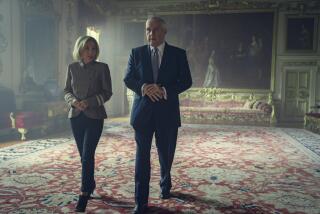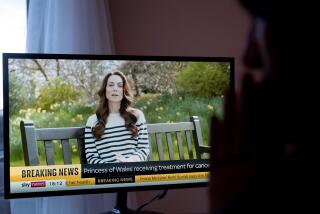But Gossip Demystifies : British Still Look Up to Royal Stars
- Share via
LONDON — When King Edward VIII met and wooed American divorcee Wallis Warfield Simpson in the summer of 1936, details of the affair were savored by gossip-hungry newspaper readers in the United States and everywhere in Europe.
Everywhere, that is, except Britain.
Britons knew virtually nothing of their king’s love affair because editors of the nation’s leading newspapers, who saw it as embarrassing and potentially degrading to the Royal Family, agreed on a pact of voluntary self-censorship.
The newspapers’ agreement typified an age when Britain’s Royal Family members were remote, porcelain-like figures, wrapped in regal mystique and presented to their subjects only in terms of reverence.
Nothing Provocative
“There was never anything provocative written; it wasn’t considered right,” recalled Godfrey Talbot, the British Broadcasting Corp.’s court correspondent for nearly 40 years before his recent retirement.
Five decades later, there is no such deference.
Britain’s newspaper editors today grasp frantically for every piece of trivia they can find about the Royal Family. When the packs of reporters they dispatch do not come back with enough, they have been known to order the writing of fiction.
In a country where change usually comes slowly, this revolution in relations between the press and the Royal Family has occurred relatively quickly.
The romance, the storybook wedding and the married life of Prince Charles and Princess Diana, who will begin a visit to Washington on Saturday, have propelled this revolution to new, occasionally disturbing, lengths. Some court observers fear that the outpouring of revelations about the royalty could eventually pose real danger to the monarchy.
A ‘Palace Dallas’
The unending scramble for snippets of royal gossip has proved to be lucrative fare for Britain’s tabloid press but has stripped Royal Family life of its regal image, portraying it more as a “Palace Dallas.”
When Charles passed up meat at a couple of public dinners, the press dubbed him a vegetarian. When Diana lost a few pounds, the tabloids immediately proclaimed anorexia. One paper even hired an American psychiatrist whose instant transatlantic diagnosis was that the princess may have been on the verge of a nervous breakdown.
Britain’s largest-circulation daily tabloid, the Sun, two years ago trumpeted the tale of a former palace kitchen assistant about Prince Andrew and his American girlfriend of the time, soft-porn actress Koo Stark, under the headline: “Queen Koo’s Romp at the Palace.”
Buckingham Palace stopped publication of subsequent stories from the same source by threatening legal action. As a result, the country was deprived of the next installment, entitled “When Barefoot Di Buttered My Toast.”
The avalanche of rumor, innuendo and gossip about Diana’s supposedly troubled marriage--including suggestions that she drove a henpecked Prince Charles to distraction with her wild spending and that he was retreating into mysticism--led the royal couple last month to give an unprecedented 45-minute television interview in an attempt to set the record straight.
British royalty has rarely responded to press reports and never at such length. Among longtime court observers, there was a sense of disquiet--both about the conduct of the press and the royal reaction to it.
“The bowing and scraping of the old days is gone, but the press must be careful not to market the Royal Family like Mars bars,” BBC alumnus Talbot cautioned. “A certain amount of the old mystery and remoteness has to be retained.”
London’s well-known gossip columnist Nigel Dempster added: “The importance of royalty is in their aloofness and exclusivity. What’s the point, if we know every silly detail about them?”
Fascination Is Fickle
There is also concern that the intensity of the coverage has generated an artificially high interest level in Britain about the Royal Family that could one day fade or even turn sour in a period of unpopularity.
“The British press were almost totally indifferent to Prince Charles, but they pursued the princess as if she were the latest Hollywood star,” noted Colin McDowell, author of a recently published book. “The danger is that Hollywood stars soon fade and are tossed aside.”
If the glare of publicity has brought long-term concern for the monarchy, it has been good economically for Britain in the short term. Diana’s patronage of British fashion has helped revive a struggling industry, and the publicity abroad has brought in more tourists and helped build a positive image for the country.
“They’ve made Britain synonymous with youth and vitality,” said Ingrid Seward, editor of Monarchy, a five-year-old British magazine devoted exclusively to royalty. “Charles and Diana are the Beatles of the 1980s.”
The forces that helped transform the relationship between British royalty and those who shape its image are spurred by a sense of what is appropriate these days. Since the end of World War II, and with increasing force, there have been efforts to play down the importance of Britain’s class system and to promote egalitarianism.
In the late 1940s, the present Queen Mother, widow of King George VI, first broke with royal tradition to mingle briefly among groups of her subjects who had gathered to see her. The gesture was wildly popular and evolved into the “walkabouts” now scheduled as part of almost all major royal tours.
Influence of Radio, TV
Television has also played a big role. Those who in an earlier era argued against radio broadcasting of royal weddings because some men might listen irreverently with their hats on were suddenly confronted with the 1953 coronation of Queen Elizabeth II carried by television into millions of British homes.
Within a few years, the tabloid press had cut its teeth on gossip--reporting about the romances of the queen’s sister, Princess Margaret, and her love for a divorced Royal Air Force pilot, Group Capt. Peter Townsend.
But it was the then-young queen, her handsome consort, Prince Philip, and their energetic young children--of whom Charles, as the oldest, was most prominent--that held the spotlight. They seemed to personify a more progressive, informal and open Britain, and as such, they captured the interest of a younger generation.
Veteran court observers say it was the palace press secretary of the mid-1960s, William Heseltine, who decided to bring this vitality more into public attention. On Christmas Day, 1969, instead of the queen’s usual holiday message telecast to the country, Elizabeth broke with tradition and gave holiday viewers an unprecedented glimpse of the Royal Family at work and at play.
Film footage of the queen receiving the newly appointed U.S. ambassador, Walter H. Annenberg, at his first royal audience, of the Duke of Edinburgh barbecuing steaks at Balmoral Castle and of a 20-year-old Prince Charles playing with his 7-year-old brother, Prince Edward, was an enormous hit, but left the British public eager to know more.
“That film was a milestone,” a member of the palace staff said recently.
The outpouring of public affection for Queen Elizabeth on her jubilee tour of the country in 1977 and for the Queen Mother during celebrations marking her 80th birthday three years later helped sustain this interest. But it was Charles’ courtship and subsequent marriage to Lady Diana Spencer that brought it to its current level.
By then, the British tabloids had found that exclusives about the Royal Family were the ultimate weapon in cutthroat circulation wars.
Merciless Pursuit
In 1981, when it appeared that Charles was about to propose to the 19-year-old nursery school teacher, the tabloid press laid siege to the frightened young woman’s London apartment, chased her mercilessly whenever she went out and once left her screaming and in tears when her small car got caught in a traffic jam and she was unable to escape a pack of reporters.
The more aloof Times of London, in its dispatch on the royal engagement, commented: “The truth is you could not write the story of the royal romance without writing the story of the stories about the royal romance.”
Those responsible for press relations at Buckingham Palace believed that the intensity of this interest would subside after the wedding, but it did not.
The tabloid press--although occasionally sidetracked by stories of Prince Andrew, whom it dubbed “Randy Andy,” frolicking with another young lovely, or by efforts to pin an extramarital affair with a Texas oil millionaire on the wife of the queen’s first cousin--has reported every waking movement of Charles and Diana’s married life.
Reporters have chartered helicopters to buzz them on ski trips in the Alps, crawled for miles through thick jungle to photograph the pregnant, bikini-clad Diana on a private beach in the Bahamas and hidden in the underbrush of the Royal Family’s domestic retreat at Sandringham.
This enormous wave of interest in the Royal Family has its effects far beyond Britain, as those who tried to wangle invitations to next week’s royal functions in Washington can attest.
Some, such as gossip columnist Dempster, point to the special appeal of the Royal Family. “They are one of a kind,” he stressed. Others talk of the younger, “Now Generation” image projected by Charles, Diana and Andrew.
Stars on a Stage
With the rise of the prince and princess as stars on the international stage, the pressure of publicity has also mounted. With photo agents willing to pay thousands of dollars for exclusive pictures, the relentless army of free-lance photographers grew larger and bolder.
Within six months of their wedding in July, 1981, Queen Elizabeth was forced to summon editors and plead for restraint for her daughter-in-law, who was then two months pregnant. A formal statement released by Buckingham Palace said, “The Princess of Wales feels totally beleaguered.”
The pressure ebbed slightly but then surged to new heights. Gradually, those who have observed Diana since the first barrage of publicity hit her 4 1/2 years ago, have watched her adjust to it and grow into her public role. But they have seen no relaxation of media pressure.
Occasionally, the royal couple manages to strike back.
On their current Australian tour, with a stiff wind blowing directly toward the press section, Prince Charles rose to inaugurate a large public fountain in the town of Mildura. Knowing precisely what was about to happen, Charles had difficulty concealing a smile as the moment arrived.
“I have the greatest possible pleasure in switching on this fountain,” he said, “and seeing where the water goes.”
More to Read
Sign up for Essential California
The most important California stories and recommendations in your inbox every morning.
You may occasionally receive promotional content from the Los Angeles Times.










